warning CHEVROLET ASTRO 2005 Owner's Guide
[x] Cancel search | Manufacturer: CHEVROLET, Model Year: 2005, Model line: ASTRO, Model: CHEVROLET ASTRO 2005Pages: 376, PDF Size: 2.45 MB
Page 280 of 376
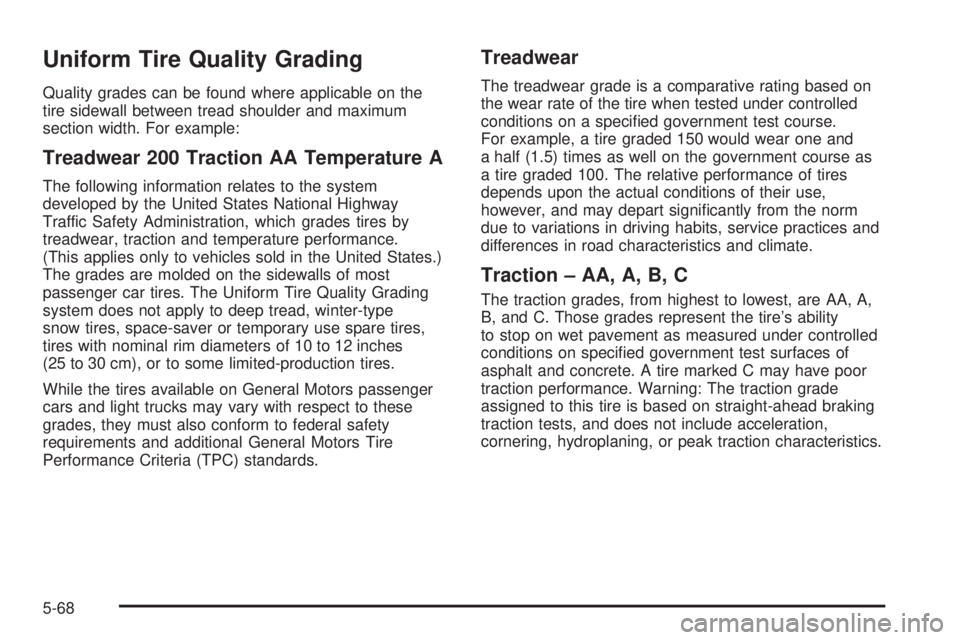
Uniform Tire Quality Grading
Quality grades can be found where applicable on the
tire sidewall between tread shoulder and maximum
section width. For example:
Treadwear 200 Traction AA Temperature A
The following information relates to the system
developed by the United States National Highway
Traffic Safety Administration, which grades tires by
treadwear, traction and temperature performance.
(This applies only to vehicles sold in the United States.)
The grades are molded on the sidewalls of most
passenger car tires. The Uniform Tire Quality Grading
system does not apply to deep tread, winter-type
snow tires, space-saver or temporary use spare tires,
tires with nominal rim diameters of 10 to 12 inches
(25 to 30 cm), or to some limited-production tires.
While the tires available on General Motors passenger
cars and light trucks may vary with respect to these
grades, they must also conform to federal safety
requirements and additional General Motors Tire
Performance Criteria (TPC) standards.
Treadwear
The treadwear grade is a comparative rating based on
the wear rate of the tire when tested under controlled
conditions on a speci�ed government test course.
For example, a tire graded 150 would wear one and
a half (1.5) times as well on the government course as
a tire graded 100. The relative performance of tires
depends upon the actual conditions of their use,
however, and may depart signi�cantly from the norm
due to variations in driving habits, service practices and
differences in road characteristics and climate.
Traction – AA, A, B, C
The traction grades, from highest to lowest, are AA, A,
B, and C. Those grades represent the tire’s ability
to stop on wet pavement as measured under controlled
conditions on speci�ed government test surfaces of
asphalt and concrete. A tire marked C may have poor
traction performance. Warning: The traction grade
assigned to this tire is based on straight-ahead braking
traction tests, and does not include acceleration,
cornering, hydroplaning, or peak traction characteristics.
5-68
Page 281 of 376
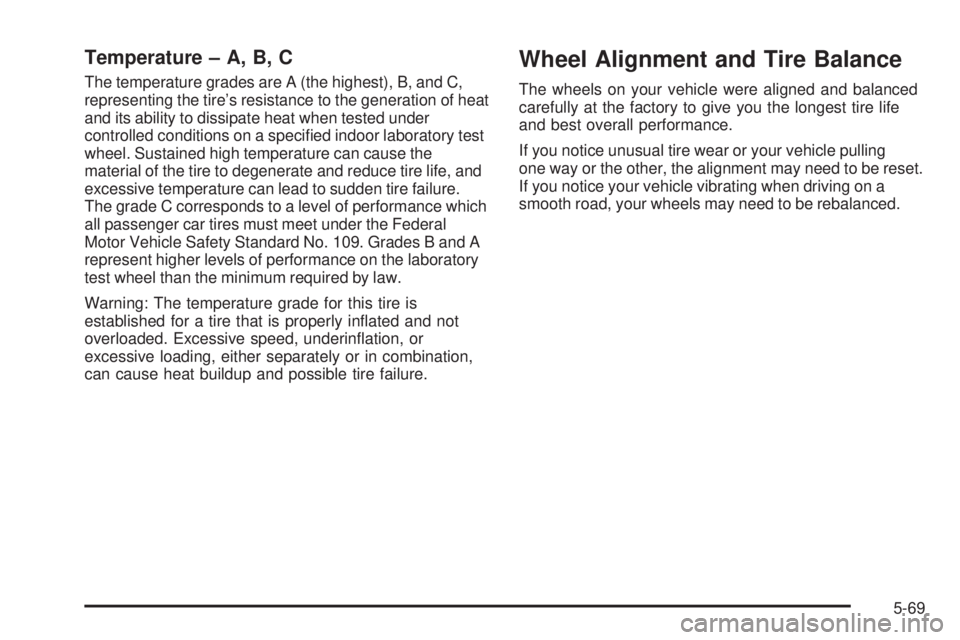
Temperature – A, B, C
The temperature grades are A (the highest), B, and C,
representing the tire’s resistance to the generation of heat
and its ability to dissipate heat when tested under
controlled conditions on a speci�ed indoor laboratory test
wheel. Sustained high temperature can cause the
material of the tire to degenerate and reduce tire life, and
excessive temperature can lead to sudden tire failure.
The grade C corresponds to a level of performance which
all passenger car tires must meet under the Federal
Motor Vehicle Safety Standard No. 109. Grades B and A
represent higher levels of performance on the laboratory
test wheel than the minimum required by law.
Warning: The temperature grade for this tire is
established for a tire that is properly in�ated and not
overloaded. Excessive speed, underin�ation, or
excessive loading, either separately or in combination,
can cause heat buildup and possible tire failure.
Wheel Alignment and Tire Balance
The wheels on your vehicle were aligned and balanced
carefully at the factory to give you the longest tire life
and best overall performance.
If you notice unusual tire wear or your vehicle pulling
one way or the other, the alignment may need to be reset.
If you notice your vehicle vibrating when driving on a
smooth road, your wheels may need to be rebalanced.
5-69
Page 284 of 376
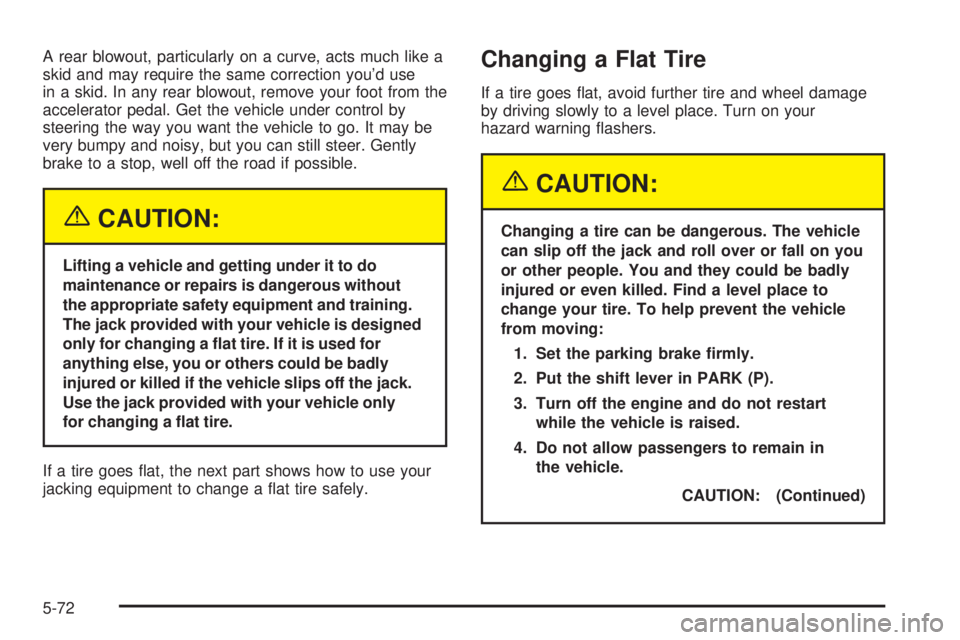
A rear blowout, particularly on a curve, acts much like a
skid and may require the same correction you’d use
in a skid. In any rear blowout, remove your foot from the
accelerator pedal. Get the vehicle under control by
steering the way you want the vehicle to go. It may be
very bumpy and noisy, but you can still steer. Gently
brake to a stop, well off the road if possible.
{CAUTION:
Lifting a vehicle and getting under it to do
maintenance or repairs is dangerous without
the appropriate safety equipment and training.
The jack provided with your vehicle is designed
only for changing a �at tire. If it is used for
anything else, you or others could be badly
injured or killed if the vehicle slips off the jack.
Use the jack provided with your vehicle only
for changing a �at tire.
If a tire goes �at, the next part shows how to use your
jacking equipment to change a �at tire safely.
Changing a Flat Tire
If a tire goes �at, avoid further tire and wheel damage
by driving slowly to a level place. Turn on your
hazard warning �ashers.
{CAUTION:
Changing a tire can be dangerous. The vehicle
can slip off the jack and roll over or fall on you
or other people. You and they could be badly
injured or even killed. Find a level place to
change your tire. To help prevent the vehicle
from moving:
1. Set the parking brake �rmly.
2. Put the shift lever in PARK (P).
3. Turn off the engine and do not restart
while the vehicle is raised.
4. Do not allow passengers to remain in
the vehicle.
CAUTION: (Continued)
5-72
Page 296 of 376
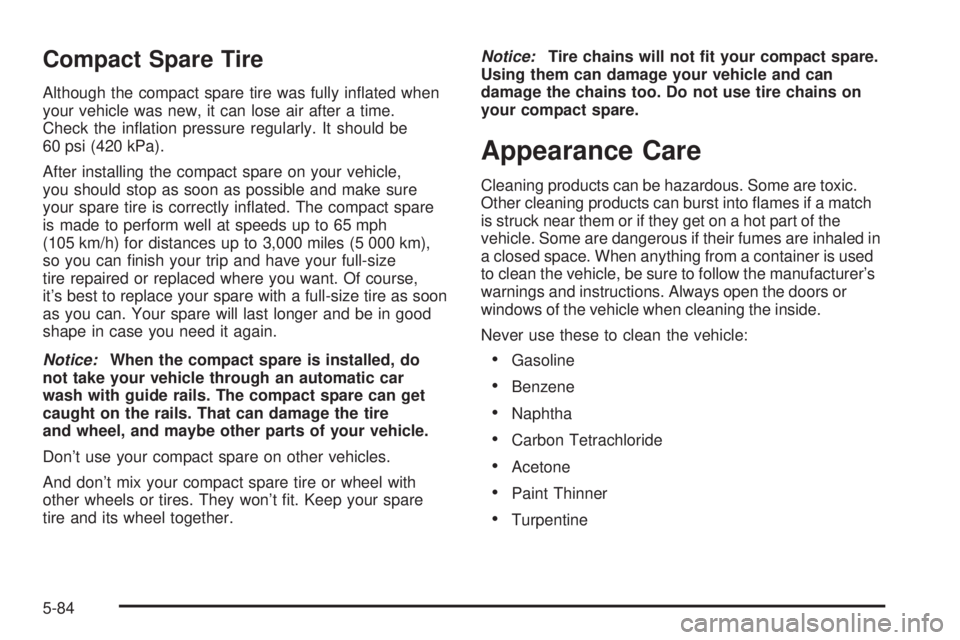
Compact Spare Tire
Although the compact spare tire was fully in�ated when
your vehicle was new, it can lose air after a time.
Check the in�ation pressure regularly. It should be
60 psi (420 kPa).
After installing the compact spare on your vehicle,
you should stop as soon as possible and make sure
your spare tire is correctly in�ated. The compact spare
is made to perform well at speeds up to 65 mph
(105 km/h) for distances up to 3,000 miles (5 000 km),
so you can �nish your trip and have your full-size
tire repaired or replaced where you want. Of course,
it’s best to replace your spare with a full-size tire as soon
as you can. Your spare will last longer and be in good
shape in case you need it again.
Notice:When the compact spare is installed, do
not take your vehicle through an automatic car
wash with guide rails. The compact spare can get
caught on the rails. That can damage the tire
and wheel, and maybe other parts of your vehicle.
Don’t use your compact spare on other vehicles.
And don’t mix your compact spare tire or wheel with
other wheels or tires. They won’t �t. Keep your spare
tire and its wheel together.Notice:Tire chains will not �t your compact spare.
Using them can damage your vehicle and can
damage the chains too. Do not use tire chains on
your compact spare.
Appearance Care
Cleaning products can be hazardous. Some are toxic.
Other cleaning products can burst into �ames if a match
is struck near them or if they get on a hot part of the
vehicle. Some are dangerous if their fumes are inhaled in
a closed space. When anything from a container is used
to clean the vehicle, be sure to follow the manufacturer’s
warnings and instructions. Always open the doors or
windows of the vehicle when cleaning the inside.
Never use these to clean the vehicle:
Gasoline
Benzene
Naphtha
Carbon Tetrachloride
Acetone
Paint Thinner
Turpentine
5-84
Page 363 of 376
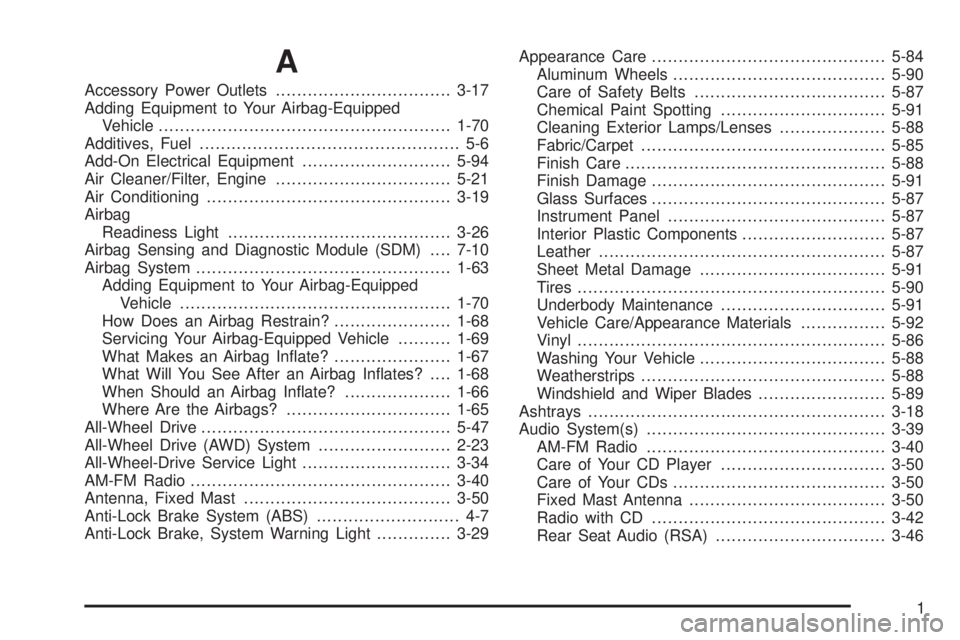
A
Accessory Power Outlets.................................3-17
Adding Equipment to Your Airbag-Equipped
Vehicle.......................................................1-70
Additives, Fuel................................................. 5-6
Add-On Electrical Equipment............................5-94
Air Cleaner/Filter, Engine.................................5-21
Air Conditioning..............................................3-19
Airbag
Readiness Light..........................................3-26
Airbag Sensing and Diagnostic Module (SDM)....7-10
Airbag System................................................1-63
Adding Equipment to Your Airbag-Equipped
Vehicle...................................................1-70
How Does an Airbag Restrain?......................1-68
Servicing Your Airbag-Equipped Vehicle..........1-69
What Makes an Airbag In�ate?......................1-67
What Will You See After an Airbag In�ates?....1-68
When Should an Airbag In�ate?....................1-66
Where Are the Airbags?...............................1-65
All-Wheel Drive...............................................5-47
All-Wheel Drive (AWD) System.........................2-23
All-Wheel-Drive Service Light............................3-34
AM-FM Radio.................................................3-40
Antenna, Fixed Mast.......................................3-50
Anti-Lock Brake System (ABS)........................... 4-7
Anti-Lock Brake, System Warning Light..............3-29Appearance Care............................................5-84
Aluminum Wheels........................................5-90
Care of Safety Belts....................................5-87
Chemical Paint Spotting...............................5-91
Cleaning Exterior Lamps/Lenses....................5-88
Fabric/Carpet..............................................5-85
Finish Care.................................................5-88
Finish Damage............................................5-91
Glass Surfaces............................................5-87
Instrument Panel.........................................5-87
Interior Plastic Components...........................5-87
Leather......................................................5-87
Sheet Metal Damage...................................5-91
Tires..........................................................5-90
Underbody Maintenance...............................5-91
Vehicle Care/Appearance Materials................5-92
Vinyl..........................................................5-86
Washing Your Vehicle...................................5-88
Weatherstrips..............................................5-88
Windshield and Wiper Blades........................5-89
Ashtrays........................................................3-18
Audio System(s).............................................3-39
AM-FM Radio.............................................3-40
Care of Your CD Player...............................3-50
Care of Your CDs........................................3-50
Fixed Mast Antenna.....................................3-50
Radio with CD............................................3-42
Rear Seat Audio (RSA)................................3-46
1
Page 364 of 376
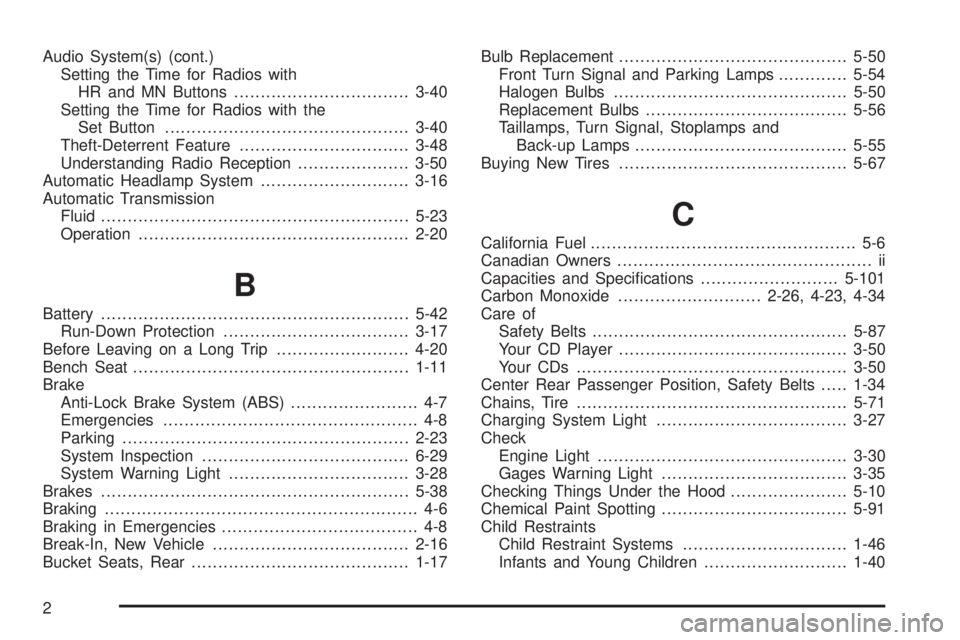
Audio System(s) (cont.)
Setting the Time for Radios with
HR and MN Buttons.................................3-40
Setting the Time for Radios with the
Set Button..............................................3-40
Theft-Deterrent Feature................................3-48
Understanding Radio Reception.....................3-50
Automatic Headlamp System............................3-16
Automatic Transmission
Fluid..........................................................5-23
Operation...................................................2-20
B
Battery..........................................................5-42
Run-Down Protection...................................3-17
Before Leaving on a Long Trip.........................4-20
Bench Seat....................................................1-11
Brake
Anti-Lock Brake System (ABS)........................ 4-7
Emergencies................................................ 4-8
Parking......................................................2-23
System Inspection.......................................6-29
System Warning Light..................................3-28
Brakes..........................................................5-38
Braking........................................................... 4-6
Braking in Emergencies..................................... 4-8
Break-In, New Vehicle.....................................2-16
Bucket Seats, Rear.........................................1-17Bulb Replacement...........................................5-50
Front Turn Signal and Parking Lamps.............5-54
Halogen Bulbs............................................5-50
Replacement Bulbs......................................5-56
Taillamps, Turn Signal, Stoplamps and
Back-up Lamps........................................5-55
Buying New Tires...........................................5-67
C
California Fuel.................................................. 5-6
Canadian Owners................................................ ii
Capacities and Speci�cations..........................5-101
Carbon Monoxide...........................2-26, 4-23, 4-34
Care of
Safety Belts................................................5-87
Your CD Player...........................................3-50
Your CDs ...................................................3-50
Center Rear Passenger Position, Safety Belts.....1-34
Chains, Tire...................................................5-71
Charging System Light....................................3-27
Check
Engine Light...............................................3-30
Gages Warning Light...................................3-35
Checking Things Under the Hood......................5-10
Chemical Paint Spotting...................................5-91
Child Restraints
Child Restraint Systems...............................1-46
Infants and Young Children...........................1-40
2
Page 367 of 376
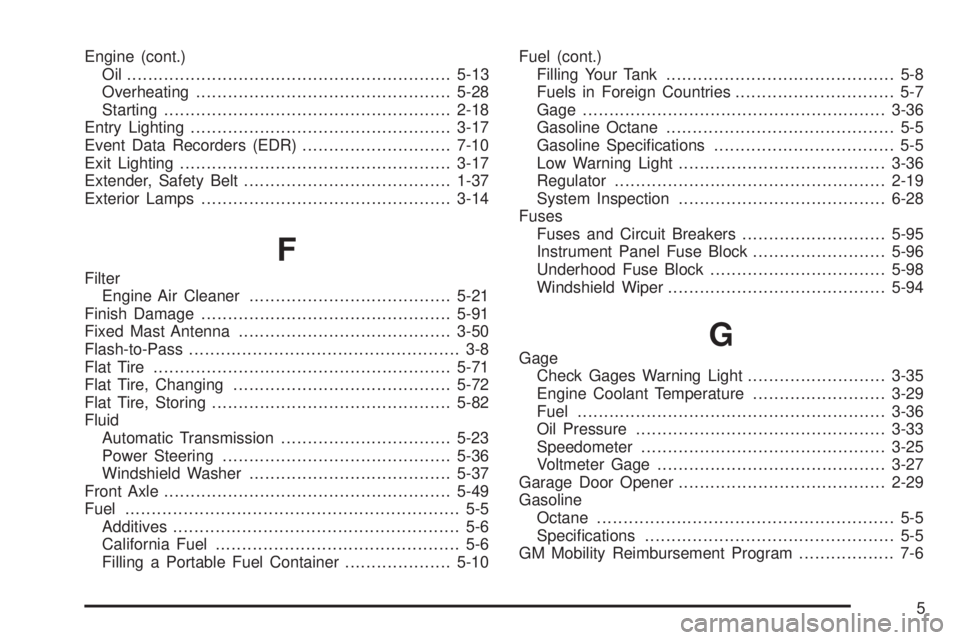
Engine (cont.)
Oil .............................................................5-13
Overheating................................................5-28
Starting......................................................2-18
Entry Lighting.................................................3-17
Event Data Recorders (EDR)............................7-10
Exit Lighting...................................................3-17
Extender, Safety Belt.......................................1-37
Exterior Lamps...............................................3-14
F
Filter
Engine Air Cleaner......................................5-21
Finish Damage...............................................5-91
Fixed Mast Antenna........................................3-50
Flash-to-Pass................................................... 3-8
Flat Tire........................................................5-71
Flat Tire, Changing.........................................5-72
Flat Tire, Storing.............................................5-82
Fluid
Automatic Transmission................................5-23
Power Steering...........................................5-36
Windshield Washer......................................5-37
Front Axle......................................................5-49
Fuel............................................................... 5-5
Additives...................................................... 5-6
California Fuel.............................................. 5-6
Filling a Portable Fuel Container....................5-10Fuel (cont.)
Filling Your Tank........................................... 5-8
Fuels in Foreign Countries.............................. 5-7
Gage.........................................................3-36
Gasoline Octane........................................... 5-5
Gasoline Speci�cations.................................. 5-5
Low Warning Light.......................................3-36
Regulator...................................................2-19
System Inspection.......................................6-28
Fuses
Fuses and Circuit Breakers...........................5-95
Instrument Panel Fuse Block.........................5-96
Underhood Fuse Block.................................5-98
Windshield Wiper.........................................5-94
GGage
Check Gages Warning Light..........................3-35
Engine Coolant Temperature.........................3-29
Fuel..........................................................3-36
Oil Pressure...............................................3-33
Speedometer..............................................3-25
Voltmeter Gage...........................................3-27
Garage Door Opener.......................................2-29
Gasoline
Octane........................................................ 5-5
Speci�cations............................................... 5-5
GM Mobility Reimbursement Program.................. 7-6
5
Page 368 of 376
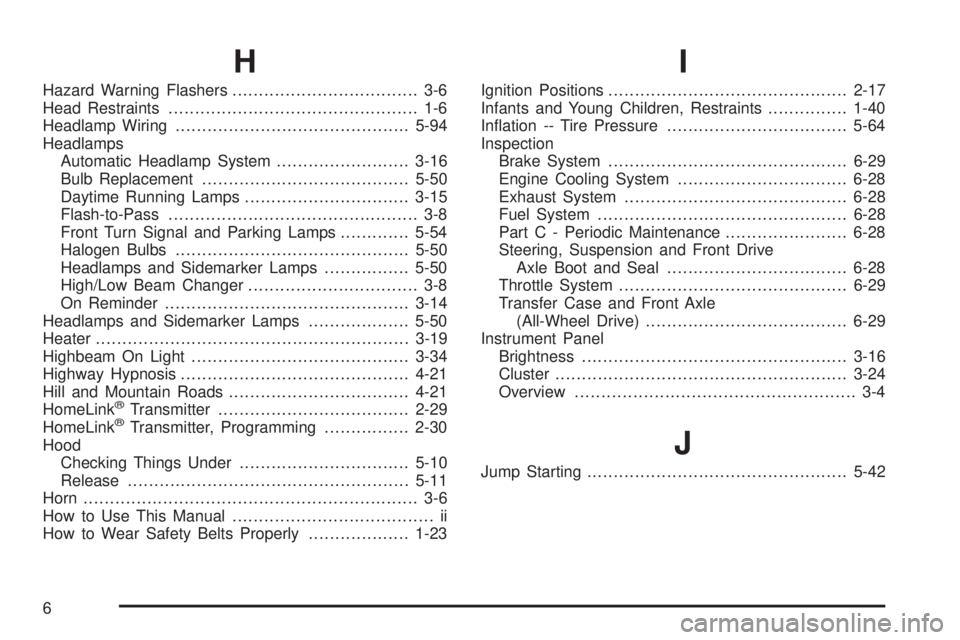
H
Hazard Warning Flashers................................... 3-6
Head Restraints............................................... 1-6
Headlamp Wiring............................................5-94
Headlamps
Automatic Headlamp System.........................3-16
Bulb Replacement.......................................5-50
Daytime Running Lamps...............................3-15
Flash-to-Pass............................................... 3-8
Front Turn Signal and Parking Lamps.............5-54
Halogen Bulbs............................................5-50
Headlamps and Sidemarker Lamps................5-50
High/Low Beam Changer................................ 3-8
On Reminder..............................................3-14
Headlamps and Sidemarker Lamps...................5-50
Heater...........................................................3-19
Highbeam On Light.........................................3-34
Highway Hypnosis...........................................4-21
Hill and Mountain Roads..................................4-21
HomeLink
®Transmitter....................................2-29
HomeLink®Transmitter, Programming................2-30
Hood
Checking Things Under................................5-10
Release.....................................................5-11
Horn............................................................... 3-6
How to Use This Manual...................................... ii
How to Wear Safety Belts Properly...................1-23
I
Ignition Positions.............................................2-17
Infants and Young Children, Restraints...............1-40
In�ation -- Tire Pressure..................................5-64
Inspection
Brake System.............................................6-29
Engine Cooling System................................6-28
Exhaust System..........................................6-28
Fuel System...............................................6-28
Part C - Periodic Maintenance.......................6-28
Steering, Suspension and Front Drive
Axle Boot and Seal..................................6-28
Throttle System...........................................6-29
Transfer Case and Front Axle
(All-Wheel Drive)......................................6-29
Instrument Panel
Brightness..................................................3-16
Cluster.......................................................3-24
Overview..................................................... 3-4
J
Jump Starting.................................................5-42
6
Page 369 of 376
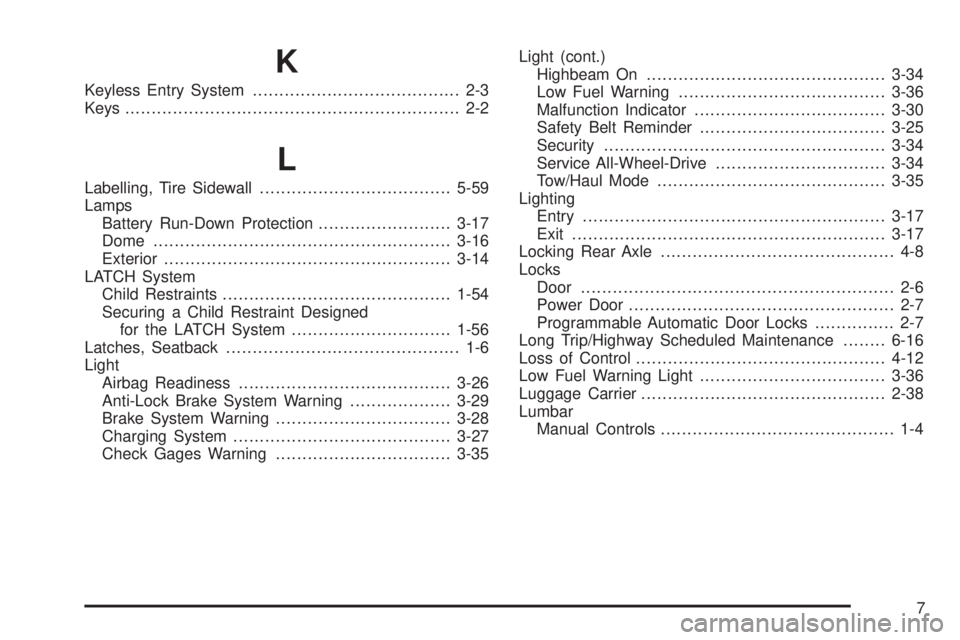
K
Keyless Entry System....................................... 2-3
Keys............................................................... 2-2
L
Labelling, Tire Sidewall....................................5-59
Lamps
Battery Run-Down Protection.........................3-17
Dome........................................................3-16
Exterior......................................................3-14
LATCH System
Child Restraints...........................................1-54
Securing a Child Restraint Designed
for the LATCH System..............................1-56
Latches, Seatback............................................ 1-6
Light
Airbag Readiness........................................3-26
Anti-Lock Brake System Warning...................3-29
Brake System Warning.................................3-28
Charging System.........................................3-27
Check Gages Warning.................................3-35Light (cont.)
Highbeam On.............................................3-34
Low Fuel Warning.......................................3-36
Malfunction Indicator....................................3-30
Safety Belt Reminder...................................3-25
Security.....................................................3-34
Service All-Wheel-Drive................................3-34
Tow/Haul Mode...........................................3-35
Lighting
Entry.........................................................3-17
Exit...........................................................3-17
Locking Rear Axle............................................ 4-8
Locks
Door........................................................... 2-6
Power Door.................................................. 2-7
Programmable Automatic Door Locks............... 2-7
Long Trip/Highway Scheduled Maintenance........6-16
Loss of Control...............................................4-12
Low Fuel Warning Light...................................3-36
Luggage Carrier..............................................2-38
Lumbar
Manual Controls............................................ 1-4
7
Page 371 of 376
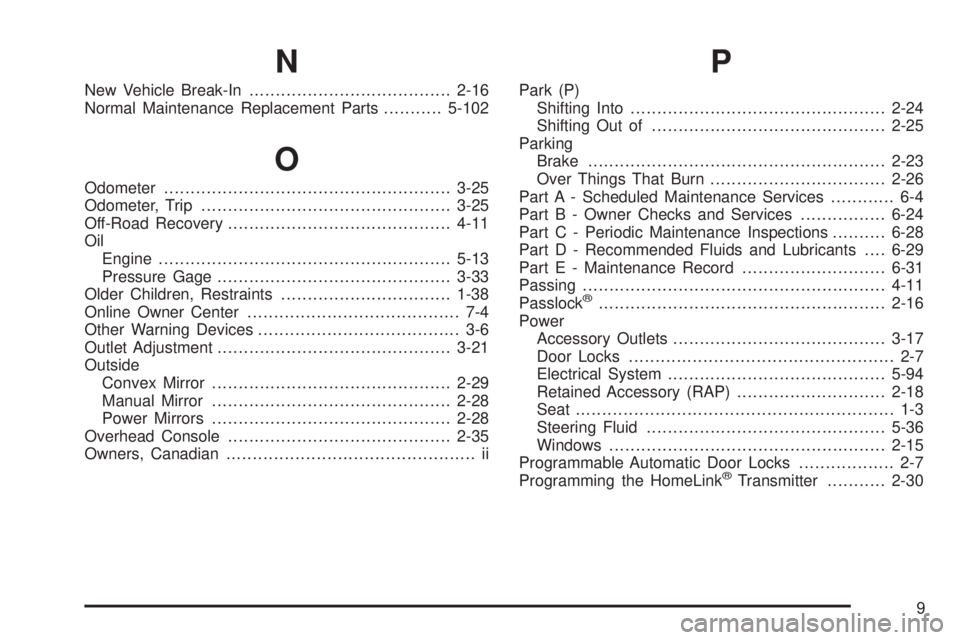
N
New Vehicle Break-In......................................2-16
Normal Maintenance Replacement Parts...........5-102
O
Odometer......................................................3-25
Odometer, Trip...............................................3-25
Off-Road Recovery..........................................4-11
Oil
Engine.......................................................5-13
Pressure Gage............................................3-33
Older Children, Restraints................................1-38
Online Owner Center........................................ 7-4
Other Warning Devices...................................... 3-6
Outlet Adjustment............................................3-21
Outside
Convex Mirror.............................................2-29
Manual Mirror.............................................2-28
Power Mirrors.............................................2-28
Overhead Console..........................................2-35
Owners, Canadian............................................... ii
P
Park (P)
Shifting Into................................................2-24
Shifting Out of............................................2-25
Parking
Brake........................................................2-23
Over Things That Burn.................................2-26
Part A - Scheduled Maintenance Services............ 6-4
Part B - Owner Checks and Services................6-24
Part C - Periodic Maintenance Inspections..........6-28
Part D - Recommended Fluids and Lubricants....6-29
Part E - Maintenance Record...........................6-31
Passing.........................................................4-11
Passlock
®......................................................2-16
Power
Accessory Outlets........................................3-17
Door Locks.................................................. 2-7
Electrical System.........................................5-94
Retained Accessory (RAP)............................2-18
Seat............................................................ 1-3
Steering Fluid.............................................5-36
Windows....................................................2-15
Programmable Automatic Door Locks.................. 2-7
Programming the HomeLink
®Transmitter...........2-30
9